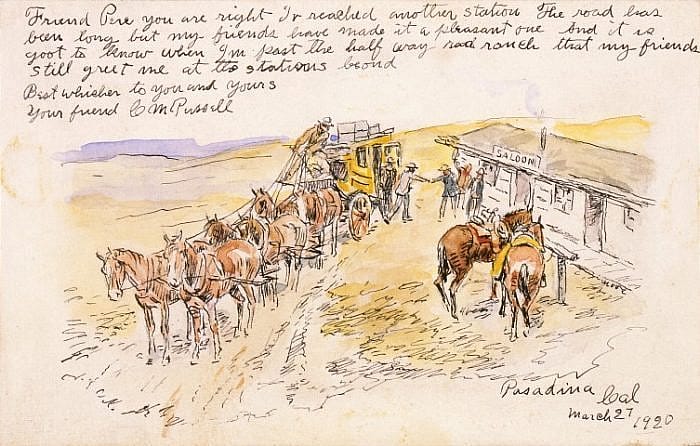
Western Treasures: Illustrated Letters from Charles M. Russell
Charles Marion Russell first travelled west to Montana in 1880 and secured a job as a night wrangler shortly thereafter. This job afforded him the opportunity to observe, document, and sketch cow camp activities. He worked as a cowboy for eleven years before becoming a full-time artist.
Russell’s life in Montana shaped his perceptions of the American West and, subsequently, his art. He would become known as the “Cowboy Artist,” and created artwork inspired by his experiences, historical events, and his own romantic visions of the West. He depicted his western subjects in oil, watercolor, ink, pencil, bronze, and wax.
Russell wore many hats. He was an artist, writer, cowboy, storyteller, and an advocate for American Indians. He was also a fabulous pen pal! Russell regularly wrote and illustrated letters to family, friends, patrons, and fellow artists. His letters are unique in that he created a sketch first – often in watercolor or ink – and then composed a narrative around the illustration. Without these personalized sketches, Russell’s letters would certainly be less extraordinary. But because of the unique nature of his illustrated letters, Russell’s notes have been viewed as works of art in their own right, and have therefore survived the years, offering historians a better understanding of their author.
The Whitney has an impressive collection of Russell’s illustrated letters, and four are currently on display. My favorites are He’s a Live One (May 3, 1907) and Friend Perc (March 27, 1920). The contrasting subject matter offers a glimpse into Russell’s singular talent and perceptions of American culture.
He’s a Live One demonstrates Russell’s love for bucking broncs, which apparently could be found even in the wilds of New York City. Writing about his trip to Manhattan, Russell mentions meeting William F. “Buffalo Bill” Cody and commends the showman for including “real” cowboys and American Indians in his Wild West. Because this letter was penned by Russell and commemorates Cody, it is considered an especially important object among the Whitney’s collections.
Friend Perc speaks to Russell’s appreciation for good friends, both in its sketch and the accompanying prose. Russell explains he has reached another station along the road from Pasadena, California to Great Falls, Montana and is greeted there by friends. Composed in 1920, only six years before the artist’s death, this illustrated letter, and others like it, reveal that Russell’s life and career were buttressed by the enduring support of his friends and family.
Due to their sensitivity to light, works on paper are not displayed for long periods of time in the Whitney Western Art Museum. As a form of radiation and heat, light can cause cracks, lifting, and changes in color to works on paper. To help control light exposure to the works on display, works are framed with special UV filtering glazing, light levels are kept low, lights are turned off during non-operating hours, and light-diffusing material is applied to nearby windows.
So, check them out before they’re gone! Stop by and see these wonderful illustrated letters by Charles Marion Russell before they return to the vaults.
Bibliography:
_____. “Charles M. Russell: 1864-1926.” Buffalo Bill Center of the West. Accessed 10 October, 2016. https://centerofthewest.org/explore/western-art/research/charles-m-russell.
_____. “Charles M. Russell.” C.M. Russell Museum. Accessed 10 October 2016. http://cmrussell.org/charles-m-russell.
Written By
Nicole Todd
Nicole Todd was formerly the Curatorial Assistant for the Whitney Western Art Museum. She graduated from the University of Oklahoma, with bachelor’s degrees in Zoology and Art History, and a master’s degree in Art History, with a focus on western American art and a specialization in Will James’s art. As Curatorial Assistant, Nicole engaged in art historical research, supported educational programming, answered public inquiries, and contributed to the Whitney’s online presence.















